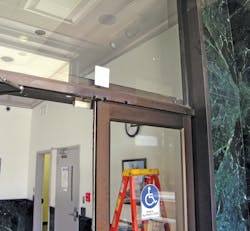A customer called because the handicapped operator on the inner vestibule doors stopped working. The building was the telephone company, and they had changed owners several times over the years, but the building and personnel had remained pretty much the same.
The setup on the inner vestibule doors was a pair of older motorized operators (no hydraulics). Entry through the inner vestibule door was via a proximity card reader and handicapped button in the vestibule. The door was always locked. A valid credential unlocked the door and pressing the handicapped button actuated the operators.
Egress was either by pushing on the CVR exit devices or pressing a handicapped button on the wall inside the lobby. Pressing the handicapped button released the locks and actuated the door operators.
When I arrived, the handicapped operator would not open the inner vestibule doors. I had to remove the full-length cover from the dual door operator to examine the patient.
The door operator had no radio controls; everything was hard-wired. Judging by date codes and the way wiring was run, this system had been installed in phases, and the operators and the electric strikes were installed during the initial construction of the building or a major renovation of the opening.
It looked like this system was rarely serviced, so it probably had been working pretty well for an extended period and so no resources were directed towards maintenance.
My first idea was that the delay module had died. Since it used a modular wiring connector, it was easy to plug in another one. This didn’t work and I noticed that no LEDs were lit in the module.
A low voltage transformer was mounted to the operator backplane. I metered it and it was not providing voltage. As shown on the accompanying schematic, the transformer powered a relay, the delay modules and the electric strikes. So with a bad transformer, the electric strikes could not unlock and no triggers would reach the door operators.
I obtained another transformer, and connected it. Now I could hear the door operators trying to open but the strikes were not unlocking. The interface relay was ancient and the installer had soldered wires to it rather than use a relay module with screw terminals. Four diodes were connected into a full wave bridge, soldered and wrapped with electrical tape. At first glance it looked like a baseball stuck up inside the door operator.
Almost immediately I determined the electric strike was not releasing, and then that the coil was shorted. That explained why the blown transformer and why the doors would not unlock.
What was so special about this installation was that the installers must have figured that the strike would last forever, so it was okay to install it so it could not be removed from the header. Apparently they shoe-horned the strike down into the header before the glass transom above the doors was installed. Therefore it would require that the large piece of glass be removed in order to get the strike out to service or replace it. The customer took me up on my suggestion that we cut the face of the aluminum header instead of removing the large piece of glass.
Gaining access to the electric strike was quite a challenge. The original installers were indeed mad scientists. Using the lock body of a Folger Adam strike, they mounted it into the extended header and notched the face so the latches would pass.
Although their one-way installation forced me to perform several hours of labor, I would recommend to Ledger readers to avoid installing things so it is impossible to service them without dismantling the building into which you are installing.
Once I pried the strike assembly out of the frame, it was déjà vu all over again. During the late 70s and mid 80s, my company sold Folger-Adam strikes and I was rather adept at stripping them down and putting them back together.
A single coil controlled both latches with a link wire. The coil had cooked after the coil had shorted. The plunger would no longer move, nor could it be removed from the solenoid.
They wrapped the coil with insulating paper tape which held the heavier flying leads to the delicate coil wires. This tape was dried out and fell apart when I began evaluating (touching) it.
Folger Adam was a major player in the electric locking industry for decades. Then they seemed to disappear from the commercial market, then they re surfaced as an Assa Abloy company under the HES tent.
I was pleasantly surprised when I called HES tech support and was able to obtain the solenoid through distribution and was able to quickly rehabilitate the strike assembly to pretty much perfect working condition.
I forced the strike back into the frame, and remounted it. It was necessary to fabricate a cover plate for the door frame.
I replaced the interface relay because, knowing its age and observing its condition, I felt it prudent to do so rather than wait for it to fail.
When I re-applied power to the system, the door operator opened the doors. But the problem was I hadn’t triggered it yet.
After more troubleshooting I discovered the inner handicapped button was in a shorted state, so it was constantly telling the operator to remain open and the strike was constantly energized.
Again, based on dates written on the equipment, it appeared that this switch had been in service for 20 years, so it was not unreasonable that it finally was worn out.
Once I replaced the switch, the door worked properly, and the customer, with whom I had shared the steps involved was ecstatic.
The troubleshooting of this system was mildly interesting, but the effort required to get the electric strike out of the frame ranks this job in the top ten of botched installs by others.
HES Electric Strike
The HES (Folger-Adam) 310-6 is an industrial grade electric strike is used on a pair of doors (without mullion) which are equipped with concealed, vertical-rod exit devices having a 1/2” or 5/8” throw latchbolt, when the spacing of the vertical rods is between 4" and 4-3/4".
Specifications:
- UL1034, burglary-resistant listed
- ANSI/BHMA A156.31, Grade 1
- DOD approved
- New York City accepted
- .51 Amps @ 12VDC continuous duty
- .25 Amps @ 24VDC continuous duty
Standard Features:
- Tamper resistant, heavy-duty construction
- Constructed entirely of stainless steel for strength and corrosion resistance
- Static strength 1,500 lbs.
- Dynamic strength 70 ft-lbs.
- Endurance 500,000 cycles
- Adjustable keeper to allow for door and frame misalignment
- Non-handed
- Fail Secure (standard)
- Plug-in connector
- Five year limited warranty
Optional Features:
- Fail Safe
- LCBMA - Latchbolt & Locking Cam Monitor with Auxiliary Switch
Note: Double-door models are available with four different center-to center dimensions between latchbolt keepers. Keepers are wide enough to compensate for vertical-rod exit bolts which may be as much as 3/8" off center-to-center dimension, either way.
When using a header mounted electric strike in conjunction with a vertical-rod device, it is necessary that:
- The bottom rod of the exit device be removed or made inoperative
- The latchbolt of the exit device be the "Pullman" or beveled type
- The latchbolt be free-latching and remain projected while the door is open.
- Mechanisms that hold the latchbolt retracted while the door is open, and automatically release it when the door is closed, must be removed or made inoperative.
For more information, contact your local locksmith distributor or HES, telephone 800-626-7590, Web Site: www.hesinnovations.com.
BEA MC-25
The MC-25 (10MC25) is a Delay on Make / Delay on Break Time Delay Module used when either a magnetic lock or electric strike is installed on an automatic door. The delay on break timer will release the lock and then the delay on make timer will enable the door to open and be held open for a set period of time.
When a momentary contact closure is applied at the input wires, RELAY 1 ( 0-7 seconds) will become active. Approximately 0.5 or 1.5 seconds after RELAY 1 becomes active, a second relay, RELAY 2, ( 0-15 seconds ) will become active. The time delay will begin as soon as the input signal is released. If another momentary contact closure is applied to the input wires during the output of RELAY 2, the entire timing cycle will begin again. RELAY 2 will not drop out, but it will be reset to the full time delay. Also, the input voltage can be supplied through the contacts of RELAY 1 by changing the position of two jumpers on the MC-25.
Specifications:
- Supply Voltage 15 to 24 VAC/VDC: - 5% to +10%
- Operating Frequency 4 MHz (Microprocessor)
- Power Consumption 10mA at rest, 50 mA max.
- Output (2) SPDT Relays
- Maximum Voltage - Relay Contact 30V DC, 120V AC
- Maximum Current - Relay Contacts 1.0A DC, 0.5A AC
For more information, contact your local locksmith distributor or BEA, telephone 800-523-2462, Web Site www.beasensors.com.
Altronix Relay Modules
Altronix manufactures many relay modules. The RB1224 is a general purpose device that can be snap track mounted, field configured for 12 or 24 VDC and has 5 Amp DPDT relay contacts, suitable for many applications.
Specifications:
• Snap track mountable relay modules.
• Current draw: 75mA
• Snap track mountable (order part # ST1).
Board Dimensions (approximate): 2.75"L x 2"W x 1"H
• 12VDC or 24VDC operation.
• 5 amp/220VAC or 28VDC DPDT contacts.
• 12VDC to 24VDC operation.
For more information, contact your local locksmith distributor or Altronix Corp., telephone 888-258-7669. Web Site:www.altronix.com.






